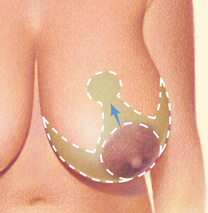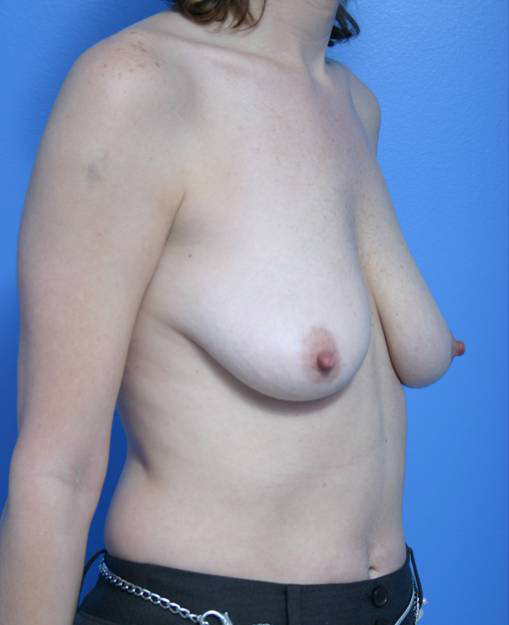Corrective Breast Surgery
There is corrective breast surgery for all types of problems, such as softening up of a hard breast (or capsular contracture). There are many ways to treat capsular contracture. The simplest technique is a capsulotomy, where the scar tissue surrounding the implant is opened up. A capsulectomy involves removal of a portion or all (complete capsulectomy) of the scar tissue. Sometimes plastic surgeons will close off one breast pocket (such as a pocket under the muscle) and create a brand new, virgin breast pocket in a new location (such as above the muscle). A final technique is creation of a neopectoral pocket, where a new pocket is made above a current under-the-muscle breast pocket. In most cases these corrective breast surgeries can result in a soft, realistic breast with no discomfort. There is, however, always a risk that the scar tissue will come back.


Other breast implant problems include implant displacement, malposition, deflation, leak, and asymmetry.
It’s also important to realize that any patient who has a complication or untoward result from previous breast surgery is at significantly higher risk than the average patient for a less-than-ideal result from revision surgery.
How long is the recovery time for corrective breast surgery?
It varies depending on what type of correction is needed. In most patients the recovery time is significantly less than with the first surgery. Dr. Youn will take extensive time during a consultation to inform you on your options available, as well as the recovery time that is necessary.
Breast Reduction (Reduction Mammaplasty)
Large, pendulous breasts may cause a woman to potentially experience various medical problems caused by the excessive weight of the breast tissue. Problems with posture, skeletal deformities, back and neck pain, skin irritations and breathing problems are common with this condition. Bra straps often leave indentations in the shoulder area. Many women, especially teenage girls, are very self-conscious if they have unusually large breasts.


Breast reduction removes fat, glandular tissue, and excessive skin, resulting in smaller, lighter and firmer breasts that are better-shaped in proportion to the rest of the body. A breast reduction always combines removal of excess skin and breast tissue with a breast lift. Traditionally, this has been performed with a scar around the areola, and then in an upside-down T-shape. The scar fades with time, over approximately 6 months to 1 year. The scar may be nearly invisible in many patients after about 1-2 years, although is still permanent.
The surgery time is usually 3-4 hours, with general anesthesia. Many patients spend the night in the hospital, although going home after a few hours is usually fine. Recovery time is about 2 weeks before going back to work, 3 weeks before going back to the gym.
During your consultation, Dr. Youn will discuss your treatment options for breast reduction surgery. Depending on your individual situation and insurance requirements, your health insurance may cover the costs of your breast reduction surgery. Unfortunately, Dr. Youn is no longer taking new insurance patients, but does perform the surgery as a cosmetic procedure.


Breast Lift (Mastopexy)
Over time, the effects of gravity along with the loss of the skin’s natural elasticity begins to have an effect on the appearance of a woman’s breasts. These factors, combined with pregnancies and nursing will often cause the breasts to lose their youthful shape and firmness.
A breast lift, or mastopexy, is a surgical procedure to raise and reshape sagging breasts. The procedure can also reduce the size of the areola (the darker skin surrounding the nipple). Breast implants inserted in conjunction with a mastopexy procedure can increase both firmness and size.
It is impossible to have a breast lift without scars. It is also important to realize that a breast augmentation alone will not lift the breasts. It will only make them larger. The only way to lift the breasts is with a mastopexy (breast lift).
Dr. Youn is using the Galashape internal mesh as an “internal bra” in some of his mastopexy surgeries. This may convey a longer-lasting result. Be sure to ask about it at the consultation.


What scars are associated with a mastopexy (breast lift)


What is the recovery from mastopexy like?
It all depends on if breast implants are used. If the breast lift is performed in conjunction with breast implant placement, the recovery time is similar to a breast augmentation (about 1.5-2 weeks). If no implants are used, the recovery can be closer to a week, although this varies per individual. Most patients wear a special support bra for 3 weeks after surgery.
Unfortunately, insurance plans do not pay for cosmetic breast lift surgery.
Nipple Ripple Reduction
The size of a patient’s nipples can be reduced using a fast and safe procedure. Inverted nipples can also be improved through minor surgery performed under local anesthesia in the office. Downtime is minimal, although patients may not be able to breastfeed afterwards.

